Guy Topper’s exploits with The Cooler and his subsequent engine development were an inspiration to Jaime de Prat Salomone. When it comes to customising a scooter you must have a clear vision of what you are trying to achieve; this one is derived from exactly that…

Jaime de Prat Salomone or ‘Jaime Supereibar’ as he is more commonly known is no stranger to the scooter scene. Hailing from Spain, even though he was actually born in America he has spent a lot of his time over in the UK following his passion of scooter racing. This passion is what inspired him to create the Lambretta you see here. At first glance it may look like a humble S1 Lambretta but in fact it started out as a 1961 Spanish Li 150 S2. Now, with varying different bodywork, it is more of a hybrid. As for the engine and what’s underneath, well that’s a totally different story.
Cool customer
Having being a fan of the UK racing scene for many years Jaime started to attend a lot of the BSSO race meetings; easier said than done when you live so far away. However the distance didn’t put him off and soon he was a regular at most meetings building up strong friendships in the paddock with a lot of the current racers. One of these was Guy Topper who has been racing Lambrettas since the 1980s. Those that remember him will recall his legendary exploits with the late Dave Webster in the early 1990s and their famous water-cooled Group 6 machine The Cooler. For those who don’t remember, this was one of the first water-cooled TS1 race engines and combined with some quite revolutionary engine development was probably the most powerful at the time. It was not only ground breaking when it first appeared but also paved the way for a lot of the modern Lambretta tuning we see today.
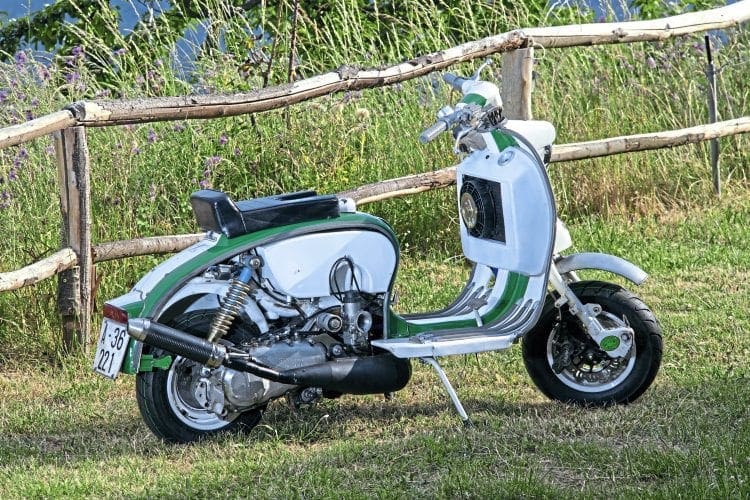
Guy’s exploits with The Cooler gave Jaime a lot to think about and ultimately prompted him to set about putting together his own creation. Having spoken to Guy about his ideas, he was more than happy to design a road going version of his Group 6 engine. This would take a lot more planning to do of course due to the fact of it going in to a standard frame, Not only would all the water-cooling system and radiators need space to be fitted but also the exhaust. On the Group 6 machine this went up over the engine but the road version would have to follow the traditional route. While this is fine it is possible to lose significant power if not formulated correctly.
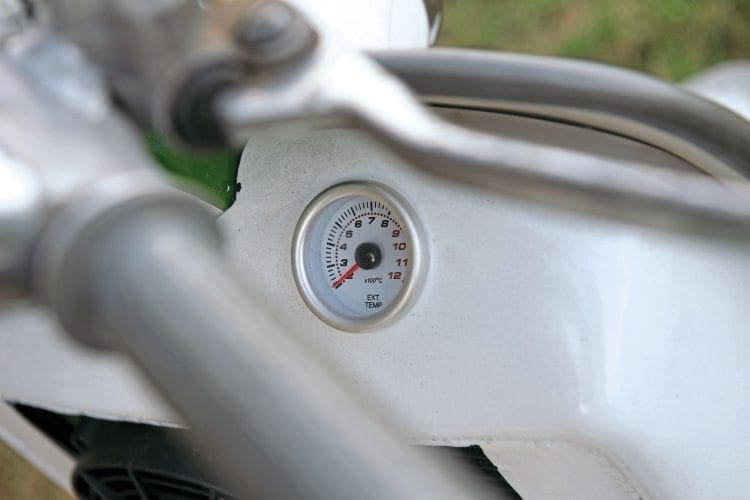
The top end was based around a TS1 cylinder which has a full jacket welded round it using the tried and trusted method Guy had developed for all his water-cooled engines. With the casings welded up to allow for bigger transfer area, power would be vastly increased. The problem isn’t creating the power it’s getting the rest of the components to cope with it. The main weak point has always been the crank — either with the big end not able to cope or the crank webs spinning. Again, Guy took inspiration from The Cooler days by fitting a Kawasaki KX Crankshaft. Still retaining a 58mm stroke with the 70mm bore, its capacity remained 225cc. However, considerable machining to the casing was required to get it to fit. The advantage is an almost bulletproof top end. The splines for the cush drive and front sprocket also needed machining to fit the Lambretta equivalent. Once done, this was a big part of the engine completed.
Transmission impossible
As with any Lambretta engine that has undergone big increases in its power output it’s always the transmission power train that takes the full force of the bhp that’s now created. While there are plenty of good chains available on the market to take up the strain, it’s always the clutch that bears the brunt of the shock. Again, there are plenty of aftermarket ones to choose from even though initially the scooter was going to have one of Guy’s Kawasaki based clutches fitted. In the end they opted instead for the Richard Taylor GT clutch. With its seven plate setup and variable choice of springs, it’s ideal to cope with the power now being thrown at it.

As for the gearing, it was fitted with a Jet 200 gearbox—the Spanish equivalent of the SX200. Renowned for being strong, this was probably the best choice even though it was modified to take a slightly shorter fourth gear. This makes the jump slightly less when changing into top gear, keeping the engine nicely in the power band and eliminating the chance of using the clutch to try and do so.
Easy start
After all the vast amount of work done to the engine, you might think Jaime would be happy. Far from it — he wanted it taken further still and asked Guy to fit an electric start system. In theory that’s a great idea but the problem comes from the fact that no such system existed for a Lambretta. Many have tried it in the past and ideas for one are now in the final stages of being developed. Realising he couldn’t just magic one out of thin air, Guy was up to the challenge and set about creating his own specifically for Jaime’s Lambretta.
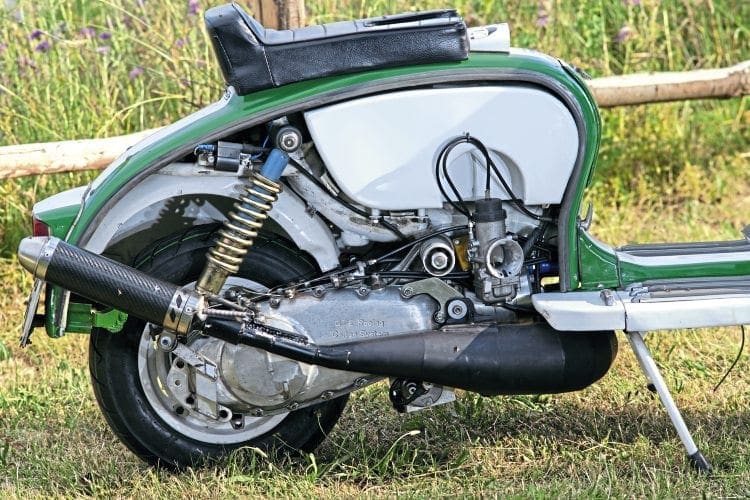
This was made slightly easier as the flywheel which would have to run a gear to the starter motor did not have the obstruction of a cooling fan – unnecessary on a water-cooled engine. Even so, it required a great deal of modification to the magneto housing as well as a mounting for the starter motor itself. With more power now required from the stator, they opted to fit a GT stator plate just to be on the safe side. Jaime says the system works well and is proud to have such a unique modification fitted to his Lambretta.
Stop start
As for the rest of the modifications, the most important one was to the front disc brake. There is no point going faster if you don’t have adequate stopping power. It would have been easy to fit one of the many now available to buy off the shelf. Yet again, trying to capture the spirit of the project, it was decided to fit the same type fitted to Guy’s Group 6 machine. This was one of the first styles of outboard discs to be developed as a result of the extra power Group 6 machines were creating almost 30 years ago now. The old hydraulic single pot conversion was struggling to cope. It uses the window half of an original Lambretta disc brake and is modified to allow a motorcycle disc to be bolted directly to it instead. With a special back plate, this holds in place a Grimeca twin pot caliper. The result is a highly responsive and efficient outboard disc capable of coping with any modern day Lambretta engine. It may look a bit old school now but the majority of the modern examples took the idea from this type of conversion.
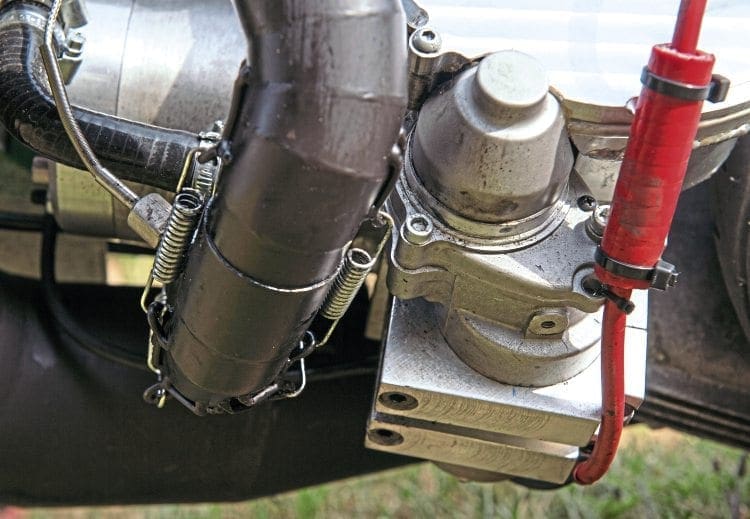
Last but not least was the fitting of the radiators and the plumbing for the water-cooling system. This has always been the hardest part of this type of conversion not necessarily because of space to fit but exactly where to place the radiator. Most times it is put on the front of the horncasting but doesn’t make for the most pleasing look on the eye. The other option is the one Jaime took: to fit it behind the leg shields in a tool box. The problem here though is the air flow that is required to the radiator to cool it down. The answer was to drill a set of holes in the leg shields to allow the air to flow through to the radiator behind. The colander type of effect may not be to everyone’s taste but is probably the best solution of the two options that were available. It also allowed a large cooling fan to be fitted behind the radiator which is an added bonus as it wouldn’t be possible to fit one if the radiator was on the front of the leg shields.
Stepping out of line
Jaime’s Lambretta at first glance doesn’t look like an out and out street racer. Far from it – if anything it looks almost like a street sleeper. This is customization of a different level. The paint scheme is basic, no product names are emblazoned across it and there is no race number on the side. The oddity of the Series 1 headset and small front mudguard disguise what it actually is. However with the side panels removed an amazing work of art is revealed in the form of its water-cooled engine. Not only that, it delivers power that most Lambretta owners would be in awe of.
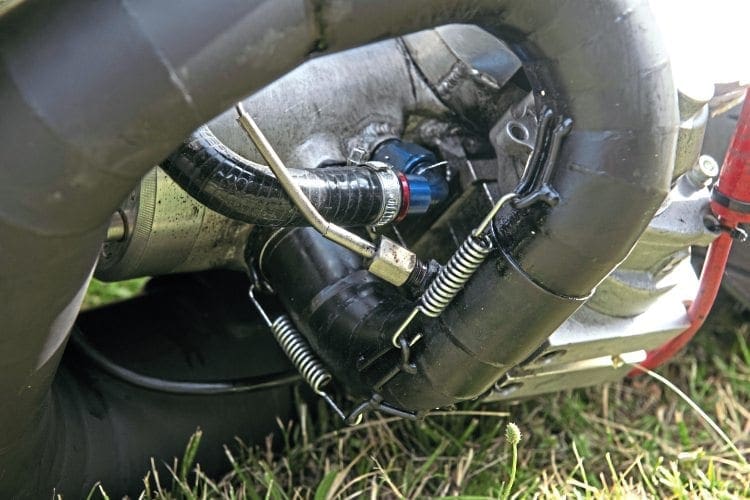
Jaime’s vision was to pay homage to Lambretta racing and in particular Guy Topper’s Group 6 race machine. He may not have gone about it in the most orthodox way, however it does what it says on the tin.
OWNER DETAILS
Name: Jaime de Prat Salomone
Job: Rentals representative at Harley-Davidson.
Scooter club & town: Lone Wolves Club from Barcelona… It’s a joke!
How and when did you first become interested in scooters: Reading Spanish comic books when I was a kid.
What was your first scooter: Lambretta Innocenti Li 125 Series III.
What is your favourite scooter model: It is a tie between the Ocre Jet200 and the Italian Series 1.
What is your favourite style of custom scooter: ‘Ratbrettas’ and super-tuned Lambrettas.
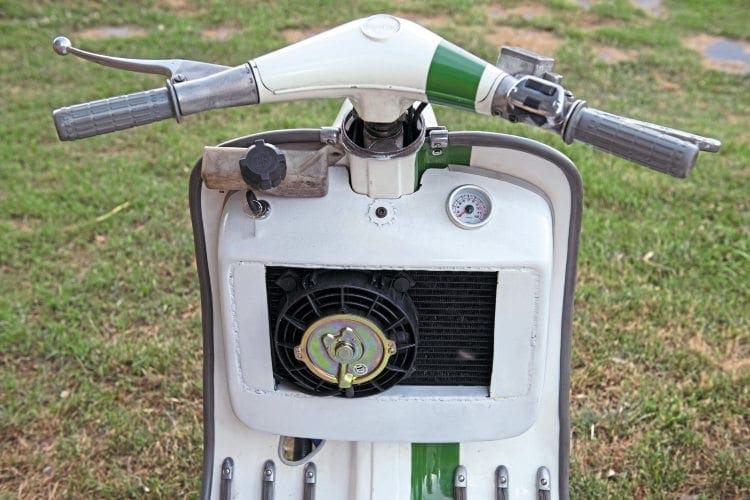
First rally or event: Some local ride back in Kentucky.
What’s the furthest you’ve ever ridden on a scooter: Barcelona to Valencia and back.
What do you like about rallies/events: I don’t do rallies. I love BSSO scooter racing, which I have been attending whenever possible since 2010.
Your favourite custom/featured scooter of all time: Lil Deuce Scoot.
If you had to recommend one scooter part or item of riding kit what would it be: The ‘Straightjackets’ that I produce at Supereibar Performances!
SCOOTER DETAILS
Name of scooter: V-1 Perfezione 225 – the V-1s were horrible bombs of retaliation in the Second World War. This scooter was originally planned as a racebike, to race in Spain against the national dominance of the Vespas. A pure weapon of retaliation. The project was abandoned after two races but the name stuck. Perfezione was a name added by Guy Topper after he introduced an engine with electric start to the frame.
Scooter model: Lambretta Eibar Li 150 Series II.
Date purchased & cost: I bought one complete bike with parts off another one and a frame for a total of €600.
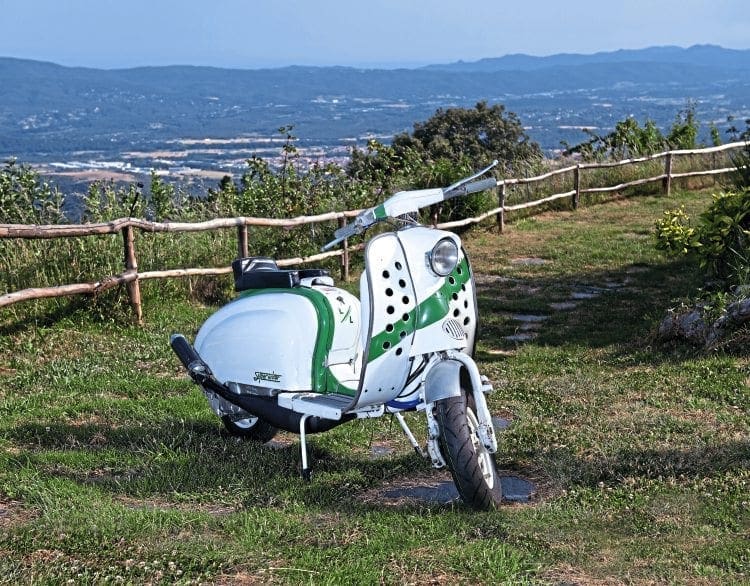
Inspiration for project: BSSO Group 6 Lambrettas.
Time to build & by who: The project to legalize the scooter for street legal use started in 2010. Initially fitted a simple Suzuki conversion done by Guy. Then it moved on to something more serious when several people participated in it. David Pacheti Paz and I did the paint job. The engine, wiring and starting system was entirely developed by Guy Topper.
Any frame modifications? What & by whom: Frame suffered damage during its racing period (2008-2009) on the left strut, so both rear frame struts were removed. Other than that it is complete. I cleaned up the frame by removing the remaining strut components.Are there any specialised parts: Guy has completely reworked the standard 200 Eibar engine that I gave him in 2012. It has a Kawasaki KX 250 crank fitted. The top end is a completely liquid cooled TS1 barrel. Guy designed the head as well as modifying the casing to accept the crank. The casing has an Aprilia RS starter adapted to it with a 12v battery on the toolbox. The EGT is carefully mounted on the toolbox, as well as the starter switch.
Engine spec: Kit: Guy Topper Engineering TS1 225 Liquid Cooled engine. Crank: 58mm Kawasaki KX 250. Carb: Dellorto VHST 24. Exhaust: Pattern/hand-crafted expansion exhaust. Clutch: Richard Taylor’s Gran Turismo Aprila RS125 clutch conversion with special GTE clutch system casing cover.
Gearbox: SX200 with DRT closer ratio fourth gear.
Porting work by: Guy Topper Engineering.
Dyno done by: No dyno work has been done

Are there any other unique details we have missed: The scooter uses a Lambro handlebar, which makes it look superbly awkward. It is an idea that was brought up by Ian Skinner (another enthusiast who helped me design the first sketches of the V-1). The handlebar was given to me by a dear friend and enthusiast we all know named Paolo Catani. Paolo, along with his Racing Lambrettas page; was and has been an inspiration for me and many other Lambretta street racing maniacs from all over the world. All I can say is that I am ever so proud of having a part of him on this project. The Nannucci mudguard is an original one I got years ago off a member of the LCGB forum named Paul ‘Storkfoot’. Scooter Loopy John did the bracket for me to mount it in the fork.
Top speed & cruising speed: Not important but I have gone well over 80mph on it.
Is the scooter reliable: Indeed. I rode it in Barcelona and in Mallorca this summer without trouble. It was HOT, however the Bosch auxiliary heating water pump, keeps the flow in the radiator going. I have not seen the EGT go over 500 degrees and trust me; I’ve been giving it the beans. So far is running rich but soon I will jet it properly

Paintwork & murals done by: David Pacheti Paz and myself. It’s not great, I know, but I had so much fun painting it with my friend Pacheti. We painted it during one of the most humid summers ever in Barcelona.
Is there anyone you wish to thank: Guy Richard Topper, the master and chief of this project along with his wife Deb, who carefully organized the final delivery. David Pacheti Paz for helping me with the paint. Tony and Charlie for delivering the scooter to me. Daz Kane for painting the rims. Paolo for the headset. Ian for his support in the early stages of this project. Doug for supplying the TS1 and countless tips. Also Giles Fielden, Richard Taylor, Scooter Loopy John, Alan Terry, Paul ‘Storkfoot’ and David Blythe.
Words: Stu Owen
Photographs: Tony O’Brien



